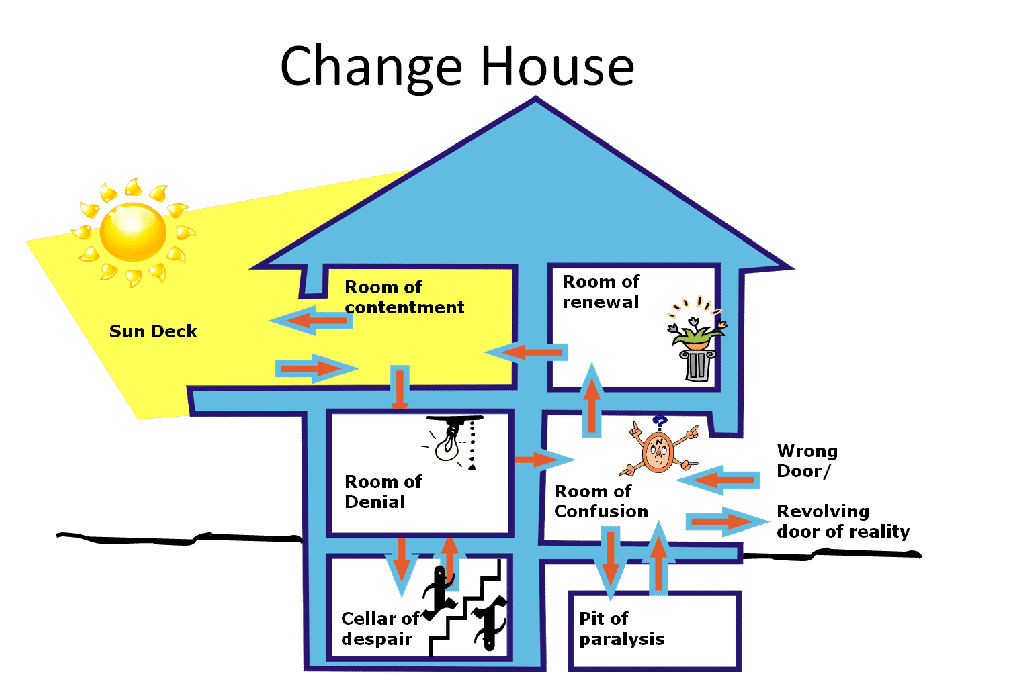
The Change House Model – Get On The Foooking Roof
There are many management models out there for changing mindset and development.
One that is becoming increasingly popular is one often referred to as: “The Change House Model“, “The House of Change Model” or the “Four Rooms of Change model”.
Contents
I Say Get Yourself On The Foooking Roof
For me being on the roof is an extension to the room of renewal you will learn about below.
“Fix the Roof While the Sun is Shining”
When things are good and going well, why change? Isn’t change only needed when something needs to be fixed? If we see personal growth as an ever-lasting process or a journey of development, then change is with us all the time.
Getting onto the roof to enjoy the sunshine, having that fresh air to think more, is better than any room in the house. You are limited only by your imagination, so having time on the roof to think more, is where the thoughts flow freely.
Four Rooms of Change
The Four Rooms of Change is a theory, a concept and a methodology with analytical instruments, models and proven best practice models. It supports innovation, development, change and transformation as well as stability and everyday business.
This video explains the benefits the 4 rooms of change have on many businesses.
What are the Four Rooms Of Change
Claes Janssen developed the model for change representing four rooms of a house:
Room of Contentment
In this room, there is a mindset in which the individual is happy enough with their lot and there is little desire to change. Everything feels good, there is no desire to learn new skills or try new ways of working. There is a sense of being relaxed. This is a positive feeling of not needing to change, such as “If it’s not broken – don’t fix it”. This room similar to denial is known as being on the dark side (for employers) because they have no urgency to improve or develop.
Room of Denial
In this room, people are aware of the change around them but decided that none of it applies to them. There is a focus of defending the status quo and blaming others. This is a negative experience of not seeking change, for example, “I’ve tried it and it doesn’t work.” Or the best excuse by many is I just do not have the time to even consider anything else. Similar to the room of contentment it is known as being on the dark because making excuses constantly instead of trying to improve within themselves and prefer to blame others.
Room of Confusion
Something feels wrong, but there is not a clear sense of what is causing this. However, change is required as people recognise a need to develop new skills and knowledge. These may be feelings of doubt or inferiority and this room can be characterised by people saying things like, “I wish I knew where I was going”. However, this room (for employers) is good because is known on the bright side because although may seem confused they have the character in wanting to develop and improve personally be become a better individual.
Room of Renewal
This is a room for creative change. There is positive energy and radical ideas emerge. People support and are committed to new approaches. Thoughts and feelings are expressed openly without inhibition and ideas of change flow. This is positive energy towards change, characterised by expressions such as, “I am going to try this”. They have trust in others, are independent and happy to take risks to continuously develop.
Break Repetitive Cycles
Depending on where you are in your life then you will be positioned in one of the four rooms.
Breakthrough these rooms to get yourself onto the roof as quickly as possible if one can.

If you study the four rooms above then work out which room you are in and once you get to the room of renewal then this is where the hatch is up to the roof.
Unless you are in the room of renewal you will never get onto the roof.
Examples to Move Through The Rooms
Here are some examples below of moving yourself through the rooms.
Best SEO Course Online
So you have the best SEO course online at present so here is your cycle that is needed:
- Contentment – If you are in the room of contentment you would not be attending a new course because of complacency. You would feel you know everything you need to know. Generally within a comfort zone and have no urgency to improve or develop as do not feel the need to.
- Denial – Then there is a move from the room of complacency to the room of denial, “Well, we don’t need to change because that is not our job” Being in this room is the worst state of mind possible. You always want to develop and improve even if you are the best at the present time. They tend to find every problem possible as their excuse.
- Confusion – Next, there was a visit to the room of confusion, “OK, maybe we do need to do something different, but I don’t know what to do, I’m fresh out of ideas!” It would be “confusion” people in attendance looking for guidance or coaching as they are the ones with the positive attitudes who would nominate for the course. Many stay in this room for too long and suffer from procrastinating aka analysis paralysis. Procrastination basically means that you are putting something off and not actually getting the work done. It is important that you don’t suffer from procrastination or ‘analysis paralysis’ in order to make the most out of your business. It is all about getting out this room to renewal and getting things started. Taking the action than learning from your mistakes in the room of renewal is fine.
More on Best SEO Course Online
- Renewal – Finally, the room of renewal gives you the answers. This dynamically forms your new agenda because you can split test what works better. There is positive energy and be open to change. The best innovations and creativity is produced when you have the attitude to ‘open to trying new ideas’.
- Roof – The crazy entrepreneurs move from renewal onto the roof. Allowing space and time for creativity, we can put one foot in front of the other when on our journey of constant improvement and growth. The process of being on the roof is delegating work, but more importantly, getting all staff in the room of renewal to move the business forward while you have the time to think on the roof to forward think two steps ahead of your competition.
The cycle runs from complacency sat sunbathing with no desire to improve -> denial blaming everyone or everything else -> confusion with open palms acknowledging the need for help and guidance/direction -> renewal when always looking to improve self & do things better.
The Finance Industry
So in the finance sector, it evolves every day. Google, Apple and Amazon have entered the banking business. During their success in the last decennium, they acquired a big cash position and now offer financial services like credit cards and commercial loans. Here is another example of the four rooms of change:
- Contentment – Our current situation is satisfying and we have no desire to change anything. We’ve been doing banking, our way for years, and it pays off. Why change? The reason you should look to change is that – If you stand still, you go backwards – period.
- Denial – Suddenly a certain event happens: new companies like Google and Apple enter the banking business. We are triggered into the next phase, The Denial Room. Yet, we don’t see the risk. Why should we change? Google hasn’t got a banking experience like us and our customers are most familiar with our bank and our ways. The possible threat is not seen as such. People even might get stuck in this phase and fall in The Dungeon of Denial.
- Confusion – When the need for change is accepted, you enter The Confusion Room. In this phase, emotions like fear, anger, and (internal) conflict take over. The situation is new to us and we don’t know how to react. How can we compete with Google? Are they also entering the mortgage market? What are other banks doing? I should have seen this coming… they had such a big cash position. It takes dedication and commitment to get to the next phase. The risks in this phase are overanalysing the current situation and possible outcomes in The Paralysis Pit, or just plain giving up via the Wrong Direction Door.
More on The Finance Industry
- Renewal – When it all falls together, we’re in The Renewal Room. We have made up our minds, we worked out a new approach and are ready to take up the challenge. We know how to deal with the new threat, we trained our clerks to respond to customer questions about Google, etc.
- Roof – But the journey doesn’t end here, we should prepare our staff for another ride through the house. We don’t know what’s up next. So as we do not yet know the future then the people on the roof should be networking tirelessly to predict the future. Give yourself the time on the roof to think. Innovators need time and open-air to innovate so work on top of the house and not in the house.
The room of contentment can feel comfortable, but that is exactly the point as it is our comfort zone. Personal growth and development come from moving beyond our comfort zone. So when we feel comfortable, maybe that tells us it’s time to change!

The image nicely sums up the various rooms in the house of change model.
For me personally, I believe the worst two places anyone can be is – making excuses in the denial room or suffering from analysis paralysis in the confusion room.
What is Your Anchor Room?
It’s a genuine personality psychology model that applies to us all. So we each have an anchor room that we always rebound into when under pressure and out of comfort zone.

The latter is the true personality type. That’s why if you press someone’s buttons in the right way, make them out of comfort, then you’ll reveal their natural personality state because they will lose their “acting” control and rebound to their anchor state.
Majority of people are in the room of denial or contentment. The simple rule is coach the bright-siders & manage the denial/contentment as while they reside in the latter 2 mindsets it is impossible to coach them. They need shocking out of their thought process.
Management Framework
It is a leadership and management framework used by huge brands with 1000 staff plus. It never fails to be wrong and helps with recruitment as you identify behavioural indicators when interviewing.
We can all learn skills, but changing deep-rooted personal characteristics is fecking hard. Needs a lot of symbolic shocking in management mode. In a relationship, it’s not too important really, but in work it’s critical.
It is possible to shift someone’s anchor room by delivering what is called a “symbolic” shock. So in management mode (NOT COACHING) make an extremely uncomfortable consequence when a wrong attitude is taken. If it impacts then people usually drop back into confusion OR dive into the dungeon and resign. Either way, you win.
People in confusion are positive people looking for help so they are bright siders who haven’t yet developed a “renewal” mindset. The negative attitudes/personality types are denial and complacency. They are the types that are negative to change and hard to develop.
Conclusion
The key to your mindset is understanding – How to avoid complacency, denial and confusion?
Nobody likes change, but we all deal with it in a different way. According to the Four Rooms of Change theory, we all go through different phases in the change process. Everybody can be in a different phase and we all have a different pace when evolving through it.
The more successful people in life can change their pace through the rooms much faster and not dwell too long in the rooms they do not want to be in.
Prepare yourselves for another ride through the house. We don’t know what’s up next but be ready for big changes and you will always fly through the rooms.
If mindset and management knowledge interests you then a great free personality test here is good to check what personality type you are.
Let us know in the comments section what personality type you are as be interesting to see the results?
All Entrepreneurship Related Posts
Check out the in-depth list of entrepreneurship posts.
- About James Dooley
- Be Positive To All Your Problems
- Ben Proctor - The Digital Workshop
- Benefits of Entrepreneurship
- Biggest Challenges Every Entrepreneur Faces
- Biggest Cities in UK
- Bolt on Wealth Acquisition Strategy
- Can I Interview You To Share on My Podcast and Social Media?
- David Goggins
- Death By A Thousand Cuts
- Digital Nomad Life Lessons
- Digital Real Estate
- Do I Need a Degree to be an Entrepreneur?
- Eliminate Single Points of Failure
- Elliot Preston - The Digital Workshop
- Encourage Learning In The Workplace
- Entering Entrepreneurship - The Digital Workshop
- Entrepreneur Salary
- Entrepreneur vs Businessman
- Expert Tips for Aspiring Entrepreneurs
- Facts About Entrepreneur
- FightMediocrity Review
- Flow State Of Mind - How To Stay Focused?
- If you are the best in the room you are in the wrong room
- Importance of Resilience in Entrepreneurship
- Innovative Entrepreneur
- Intrapreneurship vs Entrepreneurship
- Invest Into Digital Assets
- Live The Moment - It Is All About The Journey Not The Outcome
- Living a Laptop Lifestyle
- Make Money Online - Are You Crushing It?
- Meet Inspiring UK Entrepreneurs Leveraging AI
- Money Vs Happiness
- Move With The Times - DEAL WITH IT
- Power of Embracing Failure in Entrepreneurship
- Questions to Ask an Entrepreneur
- Rank and Rent
- Real Entrepreneurs Stay Clear of Multi-Level Marketing
- Risk Taker Entrepreneur
- Road to Failure - Lame Excuse "Too Busy"
- Roll Up Investments
- SEO Joint Ventures
- Serial Entrepreneur
- Successful UK Entrepreneurs You May Not Have Heard Of
- TAKE ACTION - You Create Your Own Luck
- The Change House Model - Get On The Foooking Roof
- The Digital World
- The UK's Top 100 Entrepreneurs
- The World Is My Office
- Wasted Time is Worse Than Wasted Money
- What is a Digital Landlord?
- What makes a successful entrepreneur?
- Who are the UKs leading female Entrepreneurs?
- Why Entrepreneur and not Ontrepreneur?
- Why Networking is Vitally Important
- Work Life Integration
- Work Smarter Not Harder
- Work With The End In Mind
- You Don't Know What You Don't Know
- Your Brain is Your Bitch
The full list shows the entrepreneurship articles to help you widen your knowledge.

About FatRank
Our aim to explain and educate from a basic level to an advanced on SEO and Social Media Marketing.
